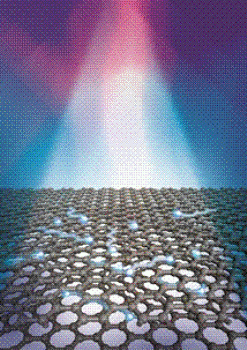Researchers at University of Maryland’s Center for Nanophysics and Advanced Materials led by Professors Michael Fuhrer and Dennis Drew and Research Associate Jun Yan have created a new hot electron bolometer with improved sensitivity and quick response time.
 Bi-layer graphene
Bi-layer graphene
A bolometer is essentially a detector of infrared light and has defence and security applications such as chemical and biochemical weapon detection, security imaging technology for airport body scanners, laboratory applications for chemical analysis and applications in astrophysics for observing the structure of the universe.
Conventional photodetectors are made of semiconductors. Electrons in a semiconductor are forbidden from occupying a certain range of energies, which is referred to as the “band gap”. The resulting ability of the electrons to absorb photons with energy higher than the band of energy is the property of significance to photodetectors. Graphene, which consists of a single layer of carbon atoms, offers improved capabilities in photodetectors over other semiconductors. Its lack of a band gap energy and ability to retain the absorbed photons make it possible to absorb low energy photons corresponding to the terahertz and infrared ranges of the light spectrum and lowers the electrical resistance of graphene. The graphene-based hot electron bolometer can be used to detect light by computing the change in electrical resistance as a result of heating caused by photon absorption by the electrons. Graphene’s electrical resistance is typically independent of temperature. By itself, it would be unsuitable for use as a hot electron bolometer. The UMD researchers therefore used a two-layered graphene which when subjected to an electric field, developed a small band gap with sufficient resistance to make it temperature dependent but at the same time, not high enough to impede the absorption of photons. The researchers found that though the sensitivity when operated at 5 Kelvin was on par with other bolometers, the response time was thousand times better. The researchers are now focusing on overcoming the limitations posed by the higher resistance of the bilayer graphene in applying it for higher frequencies and lower levels of incident light absorption.